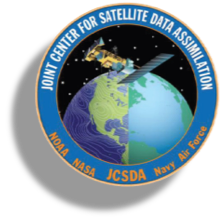Exciting advances in atmospheric chemistry data assimilation are ahead! Last week, Dr. Maryam Abdi-Oskouei presented the JCSDA team’s advances in assimilating TEMPO (Tropospheric Emissions: Monitoring of Pollution) instrument data with Joint Effort for Data assimilation Integration (JEDI) to the NASA Earth Sciences Directorate. The NASA TEMPO mission is a geostationary instrument measuring in the UV-visible bands, allowing monitoring levels of pollution over North America (NO2, HCHO, and O3) hourly during daytime at high spatial resolution. Existing polar-orbiting satellites such as TROPOMI have high spatial coverage and resolution but only provide one revisit per day, which is insufficient for tracking the daily evolution of key short-lived air pollutants. TEMPO’s hourly air quality data will help to further understand atmospheric chemistry drivers, such as but not limited to morning and evening transition times for reactive chemistry and diurnal profiles of emissions. This information will drastically improve air quality monitoring systems' predictive capabilities and the quality of the information that they will deliver to the public. Data assimilation techniques like the ones JEDI has designed for TEMPO are state-of-the-art methods to combine observation and model information to provide the best estimates of the air quality drivers (initial conditions and boundary conditions, i.e. emissions) operationally.
One of JCSDA’s missions is to accelerate and demonstrate the use of novel observations in the JEDI system. Such demonstrations serve as proof of concept for faster integration in operational forecasting at agencies such as NOAA, NASA, and provide data assimilation research capability for entities such as NSF-NCAR. Because of the genericity and flexibility of the JEDI code, TEMPO NO2 data was ingested into the JEDI system less than 24 hours after the first official release (https://www.jcsda.org/news-blog/2024/5/22/showcasing-the-assimilation-of-tempo-no2-data-in-the-jedi-system-with-the-geos-cf-model). This work has been expanded to assimilate NO2 using TEMPO and TROPOMI measurements with a 6-hourly window 4D-EnVar methodology, which can harness the full potential of the hourly TEMPO data by matching the instrument’s temporal resolution. The figure below shows the fit to observations at an hourly rate (i.e. how much closer the corrected model fields are to observations) using the GEOS-CF (https://gmao.gsfc.nasa.gov/weather_prediction/GEOS-CF/) model.
Animation map showing the JEDI TEMPO assimilation fit to observations or analysis impact. This shows the JEDI 4D-EnVar ability to fit observation at the TEMPO hourly rate.
A set of independent observations was used to validate the data assimilation methodology, a process that was made much easier by the genericity of the JEDI code. The independent observations included Pandora and Airnow ground-based measurements and measurements during NASA STAQS and NOAA AEROMMA field campaigns. This validation helps evaluate the effectiveness of the assimilation framework and also checks for issues in observation, which were a concern for TEMPO since it is the first occurrence of early morning data assimilation increments. There are lots of changes in atmospheric chemistry around sunrise as the molecules react to sunlight, and TEMPO will give us important insights into what effect this has on pollutants.
Plots illustrating quality control procedure on the TEMPO JEDI data assimilation using independent observations such as Pandora top panels and Aircraft field campaigns. The evaluation shows overall systematic improvements (black is independent observations, blue/red is the GEOS-CF model with/without TEMPO JEDI data assimilation).
As an additional test of performance, we looked at the overall root mean square of the error of three different cases: the TEMPO observation minus the GEOS-CF model without assimilation (red lines), the TEMPO observation minus the GEOS-CF model from 6 to 12-hour forecast using TEMPO observation (blue lines), and the TEMPO observation minus the actual analyses (dashed blue lines). This highlighted the importance of morning chemistry driver corrections. While the analyses show a systematic improvement throughout the day, the morning forecasts inherit data with a lack of constraints during the night and show higher error.
Time series of the root mean square (RMS) of TEMPO observation minus the GEOS-CF model without data assimilation (red), TEMPO observations minus the JEDI 4D analyses (dashed blue), and TEMPO observations minus the GEOS-CF 6 to 12-hour lead time forecasts initialized from the previous data assimilation window (solid blue).
One way to address this shortcoming is to use the JEDI data assimilation capability to adjust emissions hourly and use the previous days' scaling factors information. We are doing this by using the JEDI 4DEnVar framework for computing emission adjustments (or scaling factors) per anthropogenic sector at an hourly rate. By going to this level of granularity we can also use the statistical ensemble information to adjust other co-emitted species, such as CO, and it could be used for other pollutants in the future. The figure below shows such hourly scaling factors for key anthropogenic sectors for both NO2 and CO emission using TEMPO NO2 observations. This is truly unprecedented in atmospheric composition monitoring capability and can benefit both the scientific community and policymakers. This is an exciting step forward for JEDI, TEMPO, and atmospheric composition!
Hourly NOx and CO emission increments on the anthropogenic sectors using the JEDI 4D-EnVar source inversion and TEMPO observations.




